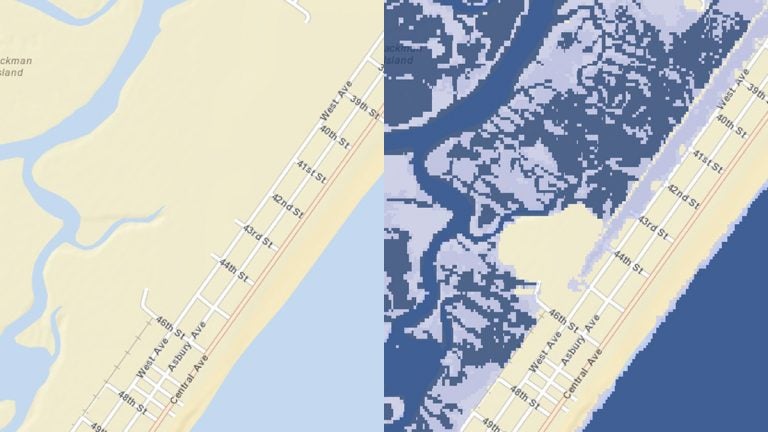Washington demands taking rising seas into account for post-Sandy projects

These images show how a 1-foot rise in the sea level in Ocean City will impact the area at high tide. (Source: Rutgers Flood Mapper)
As Jersey Shore towns ask Washington for money to bankroll post-Superstorm Sandy infrastructure plans, they’re being told to take rising sea levels in account.
The idea is build smarter, so that these pricey projects can survive the rising seas and the increased flooding the vast majority of scientists expect in the coming years.
“You know, in the past we’ve kind of looked backwards and said what happened before and made sure that we’re good enough to handle what happened in the past,” said Josh Sawislak, a senior advisor to the secretary for infrastructure resilience at the U.S. Department of Housing and Urban Development. “What we’ve learned is, the past is not a good predictor of the future when it comes to climate change.”
When HUD released the second wave of federal Sandy aid in October – $1.4 billion for New Jersey – it mandated that infrastructure projects take sea level rise into account.
HUD isn’t requiring grantees to work off a uniform set of predictions or build to withstand a certain amount of sea level rise. Rather, it wants applications to include information on how scientific predictions were considered in the proposal.
“We’re saying there’s some science that you need to use in this,” said Sawislak. “And you need to do it in a comprehensive and forward looking way, but…as you make a rational decisions and you kind of walk us through [them], show us your work, that’s really what we’re asking folks to do.”
Various government agencies have developed a Sea Level Rise Tool online to help people and communities find information about predictions for their area, because it can be tough to figure out which data to use and then, what kind of time-frame to consider – 20 years? 50 years? 100?
Whatever the timeframe, scientists expect the sea along the Jersey Shore to rise more quickly than global averages, in part because land in New Jersey is actually sinking.
By 2050, seas will rise an average of 25 centimeters (about 10 inches) from their 2000 levels around the globe, according to Ben Horton, a professor at Rutgers University who specializes in sea level rise.
But the coastal plain of New Jersey, the increase will be 45 centimeters (about 18 inches) higher than they were in 2000.
By 2100, Horton expects sea levels will be nearly 3.5 feet above where they were in 2000.
The nonprofit Climate Central took some of these local sea level rise predictions and matched them with still more information — everything from data on low-income populations to local property values. They picked out communities with high “social vulnerability.”
“It’s an evaluation of a community’s ability to prepare for, respond to, or recover from a natural catastrophe,” explained Ben Strauss, the director of Climate Central’s sea level rise program.
Climate Central’s analysis found that people who live in those “socially vulnerable” communities are twice as likely to be at high risk for flooding than the general population.
“Something else that was very interesting in New Jersey was the very high concentration of risk in a small number of zip codes,” said Strauss.
For example, almost a third of the state’s property value located less than five feet above high tide – nearly $33 billion worth of property – lies in just three zip codes: Atlantic City, Ocean City, and Beach Haven.
Atlantic City’s casinos mostly sit along the water. This city is also among the most vulnerable zip codes in terms of the number of people who live below that five-foot mark.
“It is so low and exposed on a barrier island that my guess is in the long run, Atlantic City is going to be a great challenge to defend,” said Strauss.
Hoboken, Wildwood, and Toms River also top the list of vulnerable zip codes by population.
With this information about who and what in the state will be most impacted by rising seas and the increased flooding they can cause, Strauss says there’s a great deal of planning and work communities can do to prepare. But he also thinks there will be some communities that will be beyond saving. Which places survive and which won’t will depend in part by how much communities are willing to invest to defend against encroaching water.
WHYY is your source for fact-based, in-depth journalism and information. As a nonprofit organization, we rely on financial support from readers like you. Please give today.

